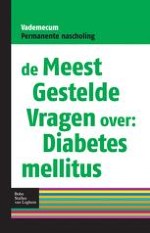Abstract
Hypoglykemie is de meest voorkomende acute complicatie van diabetes. De belangrijkste oorzaak is de relatieve overbehandeling met bloedglucoseverlagende therapie. Vooral bij behandeling met insuline en/of de insulinesecretie stimulerende tabletten (sulfonylurea en meglitiniden) is de kans op een hypo relatief groot. Zeker geldt dit bij streven naar zo laag mogelijke glucosewaarden. Uit de UKPD-Studie bleek dat in de intensief behandelde groep hypo’s bij insulinetherapie en glibenclamide vaak voorkwamen (1). Ernstige hypo’s, waarbij hulp van derden nodig was, kwamen jaarlijks voor bij 0,6% (glibenclamide ) en 2,3% (insuline) van de intensief behandelde patiënten. Symptomen wijzend op een hypo werden bij 18% (glibenclamide) en 36% (insuline) van deze categorie patiënten gevonden.
